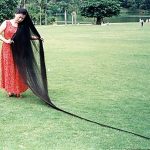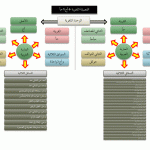Our distant ancestors were alone in their world. There were no other nations around so they couldn’t borrow words like most of the latter nations did many thousands of years later. What they saw in their environment were images of different things and different activities. The first generation stock of vocabulary they invented to express things and activities are mostly images expressed in sounds. In a way it is similar to the common abbreviation ‘WYSIWYG’ “what you see is what you get”.
When they looked at a mum feeding a baby they didn’t see “a breast”, that name came much later, but a pouch (*ṢR) full of milk because that’s one of the containers they had to store water and edible seeds – the hand of leg skin of an animal they hunted tied with a leather strip or other material. The end of the pouch is tightly joined and cut as short as possible leaving a tiny tail. This is what ancient midwives did when they cut the umbilical cord hence ‘ṢRrah’ is “belly button”. Coins made millennia later, were placed in pouches similar in shape to breasts. The person who stored coins in his pouches was the money exchanger of old times. In today’s Arabic ‘maṢRf’ is a “bank”; ‘ṢaRaf’ is “money exchanger, bank employee who cashes cheques”. The verb ‘ṢRf’ is “to spend money”. Several 21st century words with a prehistoric root copyright.
*ṢR is a root, when reversed it becomes *RṢ, and both are called linguistic pair or unit. Almost always the meanings of the two roots in a pair are connected in a category. Therefore, *RṢ means “to suckle” but the delicacy of the meaning is astonishing. ‘Ta*RṢʼ ‘ is “to inlay”, like placing tiny pieces of stone or glass of different colours in a mosaic portrait. The mosaic artist has to apply certain pressure on the tiny pieces to keep them in place but he has to be careful because it is a delicate task. This is how ancient people saw babies suckle. They didn’t bite but applied measured pressure on the nipple.
We spoke about “first generation stock of vocabulary”. The second generation was invented at the beginning of agrarian era, some 10,000-11,000 years ago by adding a letter to the bilateral roots.
Believe it or not, Arabic, 10-11 thousand years later, is expressed overwhelmingly by three-letter-base words – no more.
We were discussing a post about the origin of dancing when one of the etymology team noticed that from the same root *ṢR we have Ḫ*ṢR “waist”. It is as if the waist was conceived as a tightening area in the middle of the body. Because this is the only word for “waist” it looks as though most of our ancestors had slim bodies. The time of fat bellies was thousands of years away with the advent of the Agrarian Era.
Bishtawi is author of Origins of “Semitic” Languages, Origin of Arabic Numerals and Natural Foundations of Arabian Civilisation: Origins of alphabets, numeration, numerals, measurements and money.
http://www.amazon.com/Origin-Semitic-Languages-Arabic-Edition/dp/148179888X
Last modified: May 31, 2023



